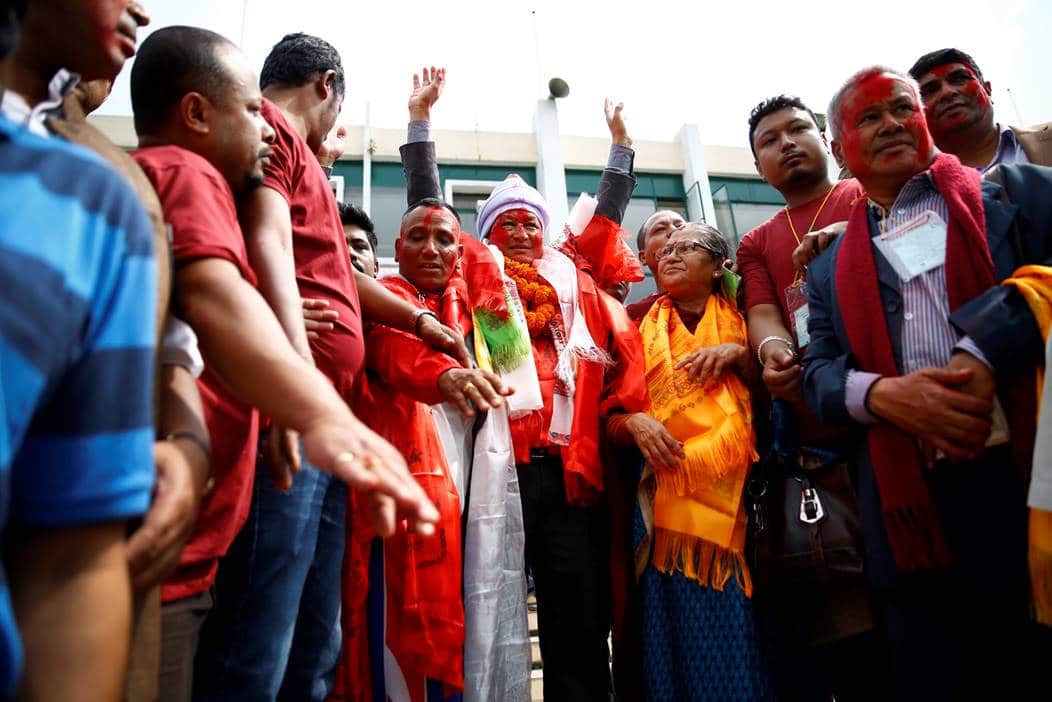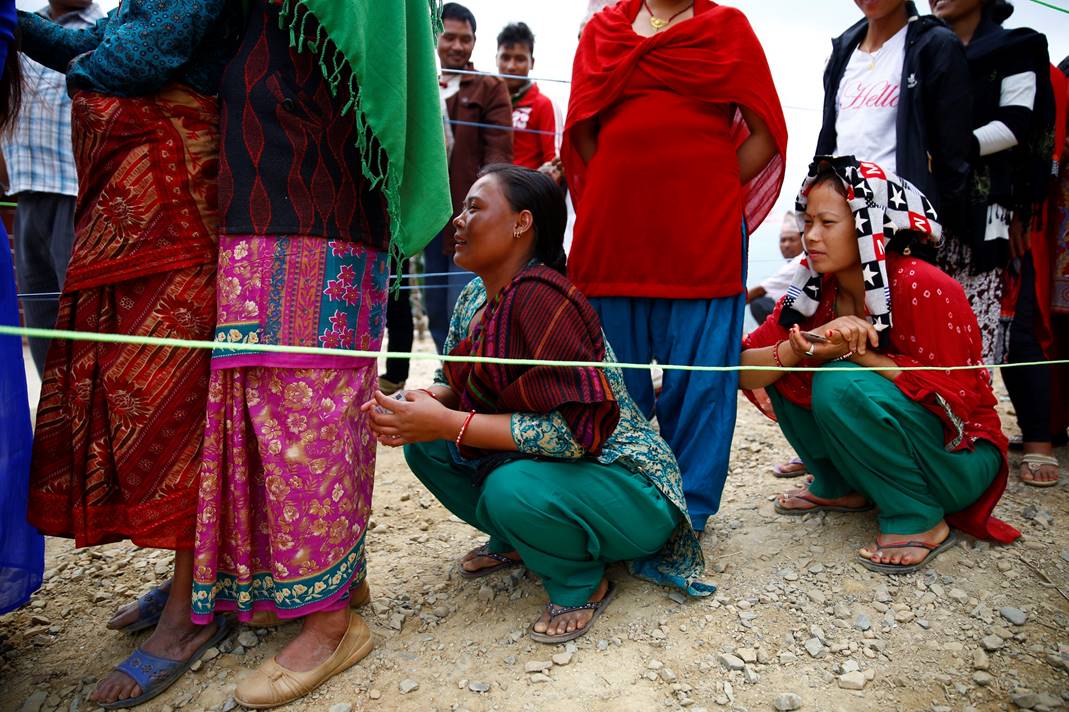
Bidya Sundar Shakya reacts after being elected the Mayor of Kathmandu in the first phase of Nepal’s local elections. With successful local elections after two decades, hopes are high that local governments will deliver on their mandates. Photo/Skanda Gautam/The Himalayan Times
In Nepal’s federal structure, power has been divided between three tiers of government, each of which has autonomy to raise and spend revenue. However, the legislative and regulatory framework for the assignment of revenue was not put in place prior to local government elections, resulting now in a confusing paralysis of claims and counterclaims emanating from old and emergent power centers. Consequently, continued progress in successful implementation of the federal provisions of the 2015 Constitution is in jeopardy.
New Legislation
Despite the many months since the promulgation of a new constitution in September 2015, it was only on July 7, 2017, nearly two months after the completion of the first phase of local elections, that two bills—the Natural Resources and Fiscal Commission Bill and the Inter-Governmental Fiscal Transfer Bills—were tabled in parliament. These bills are crucial for the management of public finance in the federal structure, overseeing revenue distribution among the three tiers of government—that is, who gets what from the national purse. While the allocation of revenue in a federal Nepal should reflect the increased responsibility of government at the local level, these bills demonstrate further progression of a worrying trend—the stalling of decentralization of governance.
The new bills give the central government an increased share of national revenue collection, at the expense of local governments. For example, the central government will retain 85 percent of taxes collected from sectors like mountaineering, hydropower, forest, mines, minerals, and other natural resources, leaving only 5 percent for local-level governments and 10 percent for provincial governments. This is a regression from the Local Self-Governance Act enacted in 1999, which assigned local bodies 50 percent of revenue collected from natural resources and hydropower, 30 percent from mountaineering and 10 percent from forests.

People line up to vote for their local election candidates. Photo/Skanda Gautam/The Himalayan Times
When viewed in the context of the nation’s total income, reducing local government’s share of the revenue generated from tourism and hydropower may seem insignificant. In the 2016-2017 fiscal year, royalties from mining, hydropower, and forestry accounted for only approximately NPR 2.5 billion—or less than 0.5 percent—of central revenue collections. In the grand scheme of things, whether local bodies take 5 percent or 50 percent of these royalties may not prove to be significant for local budgets, which can be subsidized by central grants. What is more significant and concerning is the way in which a move to reduce local government revenue generating capacity further signifies movement away from decentralization.
While the assignment of revenue is important in its own right, at its core, these latest developments demonstrate yet another barrier put up by centrist forces to maintain status quo and derail decentralization in Nepal.There has been strong public criticism of these two draft bills that reflect the status quo position of Kathmandu-based power centers. Lawmakers are now trying to amend the Inter-Governmental Financial Management Bill, which will regulate the distribution of resources between the local, provincial, and national governments, currently before the parliament. While the assignment of revenue is important in its own right, at its core, these latest developments demonstrate yet another barrier put up by centrist forces to maintain status quo and derail decentralization in Nepal.
Meaningful Decision-Making Power
The new Constitution envisages local (and provincial) governments as meaningful contributors to and drivers of the local planning process. With successful local elections after two decades in six of the country’s seven provinces, hopes are high that local governments will deliver on their mandates.
However, to do this, local governments must be sufficiently resourced and empowered. Decentralization requires newly instituted subnational governments to be given a meaningful degree of decision-making power in order to execute their given responsibilities. This autonomy only comes when local governments are able to raise their own revenue and set their own budgets. However, far from providing increased fiscal authority, these new bills are moving in the opposite direction.
The Bigger Picture: A Trend Away from Decentralization
To the casual observer, this debate may seem like (yet another) dispute among the political elite over the division of the country’s spoils—newly elected mayors wanting a seat at the table, and their share of the revenue pie. However, this is not merely a question of who has access to the country’s finances; this issue goes to the heart of the decentralization agenda in Nepal.
Nepal has already failed to learn an important lesson from the unsuccessful implementation of the Local Self-Government Act. With 744 local governments, Nepal has opted for local bodies that only have on average 40,000 residents. However, experts suggest international experience shows that local governments should have a minimum population of between 100,000-200,000 residents in order to be of sufficient scale to effectively manage key public services such as education and health.
This will be an impediment to the decentralization of functions to local governments, which are too small to perform their designated functions, and will likely lead to a system where central line ministries will effectively retain decision-making power. If passed, the bills before parliament are another disturbing sign for institutionalizing meaningful decentralization in the country.
Charting a Way Forward
Nepal’s Constitution provides for a relatively fiscally centralized system. The central government retains all major revenue sources—such as individual and corporate income taxes, and VAT; provincial and local governments are only assigned a limited number of comparatively low-yielding revenue sources, such as property and vehicle taxes. However, in a context where subnational governance systems are required to be built from the ground up, and in which revenue-raising potential will vary greatly from province to province, this design is appropriate. Local governments should not be expected to raise the lion’s share of their own revenue; gaps will need to be filled by intergovernmental fiscal transfers.
The fact that a considerable share of the financing for provincial and local government budget will come via intergovernmental fiscal transfers is not in and of itself cause for alarm; it does not mean that these subnational governments will lose their independence, per se. However, what is concerning is the manner in which, once again, centralized political forces in Kathmandu are seeking to flex their muscle at the expense of strong local governance.
Iain Payne is the New Colombo Plan Nepal Fellow, researching federalism and interning with The Asia Foundation in Nepal, and Binayak Basnyat is an Asia Foundation program associate in Nepal. The views and opinions expressed here are those of the authors and not those of The Asia Foundation or its funders.
http://asiafoundation.org/2017/07/26/federal-provisions-nepals-constitution-jeopardy/

This article was originally published on The Asia Foundation’s blog In Asia. Would appreciate it if you could cite the original source, and include a link: http://asiafoundation.org/2017/07/26/federal-provisions-nepals-constitution-jeopardy/